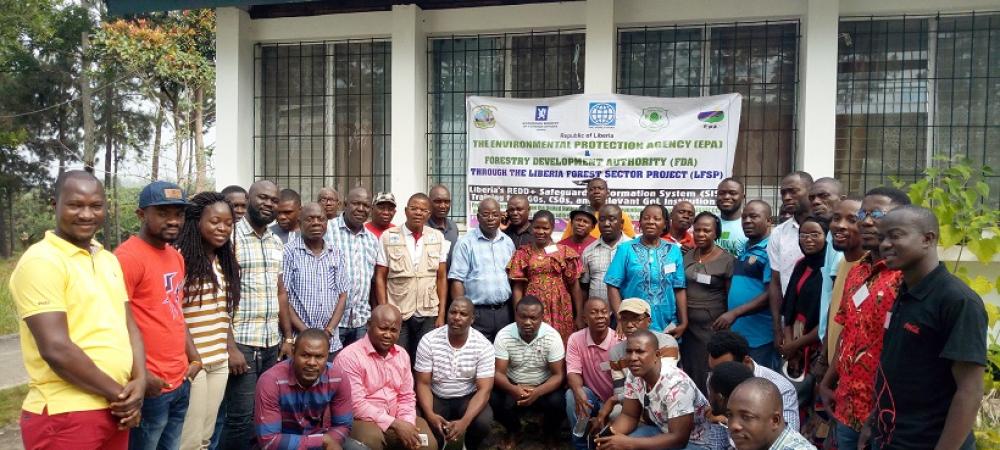
The Environmental Protection Agency of Liberia (EPA) and the Forestry Development Authority (FDA) over the weekend concluded a two-day REDD+ Safeguards Information System (SIS) training organized for representatives of civil society organizations (CSOs), Non-governmental Organizations (NGOs) and line government ministries and agencies in Tubmanburg, Bomi County.
REDD stands for Reducing Emissions from Deforestation and Forest Degradation in Developing Countries while “+” signifies + conservation of forests, + sustainable management of forests and + enhancement of forest carbon stocks.
The REDD+ Safeguards Information System (SIS) was developed by the EPA and the Forestry Development Authority (FDA) with funding from the Forest Carbon Partnership Facility (FCPF) under the World Bank to provide information on how the United Nations Framework Convention on Climate Change (UNFCCC) REDD+ ‘Cancun’ safeguards are being addressed and respected throughout the implementation of the national REDD+ Strategy.
The two-day REDD+ SIS, which attracted participates from the Lake Piso Basin and Gola National Park was held at the Forestry Training Institute (FTI) on 31st January and 1st February 2020 enabled participants assess the fullness and the user friendliness of the system. Also, the training empowered participants fully understand the institutional arrangements and data collection processes relative to the system. Participants were also drilled through the SIS reporting requirements and taught how to report using the template.
Making opening remark, Atty. Roland Lepol of the REDD+ implementation Unit (RIU) lauded the EPA and the FDA for organizing the training and said the SIS is a requirement for the implementation of the REDD+ activities in Liberia.
Atty. Roland Lepol said that the development of the SIS is a massive achievement for the government and the overall implementation of the REDD+ activities in Liberia.
He lauded the EPA for organizing the second part of the SIS training and disclosed that the RIU is charged with the responsibility to coordinate the implementation of the Liberia Forest Sector Project (LFSP) under which the operationalization of the SIS is being done.
He indicated that the development of the SIS was bankrolled by the additional REDD+ Readiness Project through the LSFP. Hence, the Additional REDD+ Readiness Project is funded by the World Bank.
According to him, the LSFP is funded by the Norwegian Government through the World Bank with the objective to improve management of and increase benefit sharing for forest management in Liberia.
Atty. Lepol noted that the EPA is one of the Project Implementing Entities (PIEs) under the LFSP that is helping to improve regulation for environmental management which also supports the implementation of REDD+.
He explained that the SIS is a very important building block for our REDD+ Readiness.
Also speaking at the opening session, Z. Elijah Whapoe, Focal point of the LFSP and Manager of planning and Policy at the EPA lauded participants for honoring invitation to attend the training and cautioned them to make maximum use of the opportunity.
Mr. Whapoe disclosed that a previous training on REDD+ Safeguard Information System was held in Ganta from 17-18 January 2020.
He explained that the system was developed with the help of Conservation International (CI) and it is one of the first in Africa.
According to him, the training is technical and it would be a hand-on exercise.
At the SIS training, Mr. Whapoe used the occasion to inform the audience that members of the Green Climate Fund (GCF) Board are expected to meet in Liberia for the first time and said the gathering will contribute to the economy.
Liberia is a party of the UNFCCC and is under obligation to among many others develop a REDD+ Safeguard Information System.
For his part, Nick Benitos Goll, II, Environmental Safeguards Coordinator for the LFSP/ REDD+ Project in Liberia, said the SIS system is an easy to use system that builds on existing information systems, which seeks to ensure that information is accessible in an appropriate format to meet the needs of different stakeholders.
In a powerpoint presentation, Mr. Goll explained that the system produces summaries of information on REDD+ safeguards for the United Nations Framework Convention on Climate Change (UNFCCC).
According to him, the system also provides assurances on safeguards implementation and non-carbon benefits to donors, international companies and markets information to Liberian government on contributions to sustainable development assurances to local stakeholders on their social and environmental priorities.
Providing information on the seven REDD+ Safeguards in the UNFCCC, Mr. Goll disclosed that when undertaking REDD+ activities, a country must promote transparent and effective national forest governance structures, respect the rights of indigenous peoples and members of local communities and promoted the full and effective participation of relevant stakeholders.
He indicated that the protection and conservation of natural forests and their ecosystem as well as the enhancement of other social and environmental benefits are also essential measures a country undertaking REDD+ must strive to achieve.
Mr. Goll encouraged members of the public to access information on REDD+ information on the platform at: https://liberia-redd-sis.info/.
EPA IT Technician, Ujay Vah said that the portal is developed on a web-server using WordPress content management System and APP Gini PHP web database application.
Providing an overview of the REDD+ SIS, Mr. Vah indicated that the user’s manual consists of three sections: Safeguards Information System Website, Safeguards Information System Database, and Important notes for System Administrators.
EPA GIS Officer, Lucas T. Knight in a presentation title: “Introduction to the Safeguard Information System SIS Backend” defined backend as the server side of a website.
He disclosed that the backend stores and arranges data, and also makes sure everything on the client-side of the website works fine.
“It is the part of the website that you cannot see and interact with,” Mr. Knight said.
He noted that the backend consists of three key elements of a website, i.e., application, web server and database.
For his part, Sanford V. Daniels, a GIS officer at EPA reiterated that the Liberia REDD+ Safeguards Information System is a web-based portal for providing and disseminating information on how the seven (7) adopted UNFCCC Cancun safeguards for REDD+ are being addressed and respected in Liberia.
The system, he said provides visibility on the implementation of REDD+ in Liberia.



